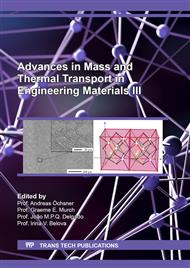p.3
p.19
p.26
p.43
p.53
p.63
p.73
p.91
Increasing the Certainty to Estimate 1-Gravity (1-g) Separation Time Based on any-g Force (N) and g- Equivalent Concepts
Abstract:
As it is well established, Stokes law has been used to calculate the time required to precipitate a particle in a fluid under specific conditions such as sphericity, laminar flow, differences on densities (particle and fluid) and fluid viscosity for a specific gravity force (g). However, when the separation under 1-g takes days or months and it is crucial to estimate that time in just minutes, the separation time at 1-g can be estimated making a relationship with any other g (n). However, in any centrifuge the n value is not reached instantaneously but in a specific time and during this time the g-value is never constant, but it is always growing (at the first stage). Then, after reaching the n-value, the centrifuge could stay at that value for a certain time and then, (the third stage) the n value will change again, this time decreasing. Therefore, the aim of this study is to establish a mathematical model that considers the acceleration and deceleration periods and expresses them as equivalents of the n period by using a numerical approach [1-3]. It is expected the g-equivalent concept increases the certainty of the separation time estimation.
Info:
Periodical:
Pages:
19-25
Citation:
Online since:
November 2022
Authors:
Keywords:
Price:
Сopyright:
© 2022 Trans Tech Publications Ltd. All Rights Reserved
Share:
Citation:


